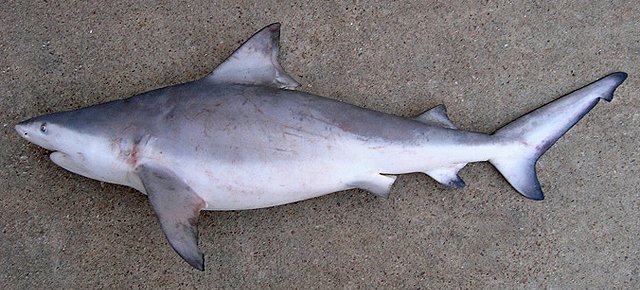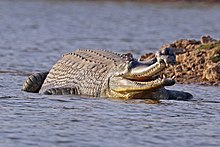Post by dinosauria101 on Jul 10, 2019 17:26:33 GMT 5
Ganges Shark - Glyphis gangeticus
The Ganges shark (Glyphis gangeticus) is a critically endangered species of requiem shark found in the Ganges River (Padma River) and the Brahmaputra River of Bangladesh and India. It is often confused with the more common bull shark (Carcharhinus leucas), which also inhabits the Ganges River and is sometimes incorrectly referred to as the Ganges shark. Unlike bull sharks, which need to migrate to salt water to reproduce, species in the genus Glyphis are true river sharks. G. gangeticus is a little-known species that is yet to be adequately described. Its size at birth is 56 to 61 cm (22 to 24 in), growing to an estimated 178 cm (70 in) at maturity, with a maximum size of about 204 cm (80 in). The size at birth or maturity is unknown for any other Glyphis species. A typical requiem shark in its external appearance, it is stocky, with two spineless dorsal fins and an anal fin. The Ganges shark, as its name suggests, is largely restricted to the rivers of eastern and northeastern India, particularly the Hooghly River of West Bengal, and the Ganges, Brahmaputra, and Mahanadi in Bihar, Assam, and Odisha, respectively. It is typically found in the middle to lower reaches of a river. One found in 2018 in a Mumbai fish market may have come from somewhere along the banks of the Arabian Sea.

Indian Gharial (Gavial) - Gavialis gangeticus
The gharial (Gavialis gangeticus) is a crocodilian of the family Gavialidae that is native to the Indian subcontinent and also called gavial and fish-eating crocodile. The gharial is one of three crocodilians native to India, apart from the mugger crocodile and the saltwater crocodile. It is one of the longest of all living crocodilians. Gharials' well-developed laterally flattened tail and webbed rear feet provide tremendous manoeuvrability in their deepwater habitat. On land, however, an adult gharial can only push itself forward and slide on its belly. Further enhancing its swimming abilities, the body of the gharial is relatively cylindrical in shape, compared with the broader, more powerfully-built body of a saltwater or nile crocodile built for capture various prey from the edges of waterways. The Gharial's elongated, narrow snout becomes proportionally shorter and thicker as an animal ages. The average body weight of the species is from 159 to 250 kg (350 to 550 lb). Males commonly attain a total length of 3 to 5 m (9.8 to 16 ft), while females are smaller and reach a body length of up to 2.7 to 3.75 m (8.9 to 12.3 ft). The three largest examples reported were a 6.5 m (21 ft) gharial killed in the Gogra River of Faizabad in August 1920; a 6.3 m (21 ft) individual shot in the Cheko River of Jalpaiguri in 1934; and a giant of 7 m (23 ft), which was shot in the Kosi River of northern Bihar in January 1924. Such exceptionally larger specimens can scale up to 977 kg (2,150 lb) in mass. While specimens of over 6 m (20 ft) were not uncommon in the past, such large individuals are not known to exist today. Gharials are exceeded in length only by the saltwater crocodile.

Credit to Wikipeida
The Ganges shark (Glyphis gangeticus) is a critically endangered species of requiem shark found in the Ganges River (Padma River) and the Brahmaputra River of Bangladesh and India. It is often confused with the more common bull shark (Carcharhinus leucas), which also inhabits the Ganges River and is sometimes incorrectly referred to as the Ganges shark. Unlike bull sharks, which need to migrate to salt water to reproduce, species in the genus Glyphis are true river sharks. G. gangeticus is a little-known species that is yet to be adequately described. Its size at birth is 56 to 61 cm (22 to 24 in), growing to an estimated 178 cm (70 in) at maturity, with a maximum size of about 204 cm (80 in). The size at birth or maturity is unknown for any other Glyphis species. A typical requiem shark in its external appearance, it is stocky, with two spineless dorsal fins and an anal fin. The Ganges shark, as its name suggests, is largely restricted to the rivers of eastern and northeastern India, particularly the Hooghly River of West Bengal, and the Ganges, Brahmaputra, and Mahanadi in Bihar, Assam, and Odisha, respectively. It is typically found in the middle to lower reaches of a river. One found in 2018 in a Mumbai fish market may have come from somewhere along the banks of the Arabian Sea.
Indian Gharial (Gavial) - Gavialis gangeticus
The gharial (Gavialis gangeticus) is a crocodilian of the family Gavialidae that is native to the Indian subcontinent and also called gavial and fish-eating crocodile. The gharial is one of three crocodilians native to India, apart from the mugger crocodile and the saltwater crocodile. It is one of the longest of all living crocodilians. Gharials' well-developed laterally flattened tail and webbed rear feet provide tremendous manoeuvrability in their deepwater habitat. On land, however, an adult gharial can only push itself forward and slide on its belly. Further enhancing its swimming abilities, the body of the gharial is relatively cylindrical in shape, compared with the broader, more powerfully-built body of a saltwater or nile crocodile built for capture various prey from the edges of waterways. The Gharial's elongated, narrow snout becomes proportionally shorter and thicker as an animal ages. The average body weight of the species is from 159 to 250 kg (350 to 550 lb). Males commonly attain a total length of 3 to 5 m (9.8 to 16 ft), while females are smaller and reach a body length of up to 2.7 to 3.75 m (8.9 to 12.3 ft). The three largest examples reported were a 6.5 m (21 ft) gharial killed in the Gogra River of Faizabad in August 1920; a 6.3 m (21 ft) individual shot in the Cheko River of Jalpaiguri in 1934; and a giant of 7 m (23 ft), which was shot in the Kosi River of northern Bihar in January 1924. Such exceptionally larger specimens can scale up to 977 kg (2,150 lb) in mass. While specimens of over 6 m (20 ft) were not uncommon in the past, such large individuals are not known to exist today. Gharials are exceeded in length only by the saltwater crocodile.

Credit to Wikipeida




